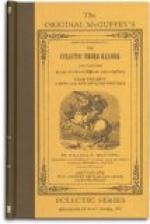Many other artists, when asked such a question, would have either set about detailing the mechanical composition of such and such colors, in such and such proportions, rubbed up so and so; or perhaps they would (and so much the better, but not the best) have shown him how they laid them on; but even this would leave him at the critical point. Opie preferred going to the quick and the heart of the matter: “With brains, sir.”
Sir Joshua Reynolds was taken by a friend to see a picture. He was anxious to admire it, and he looked it over with a keen and careful but favorable eye. “Capital composition; correct drawing; the color, tone, chiaroscuro excellent; but—but—it wants—hang it, it wants—that!” snapping his fingers; and, wanting “that,” though it had everything else, it was worth nothing.
Again, Etty was appointed teacher of the students of the Royal Academy, having been preceded by a clever, talkative, scientific expounder of aesthetics, who delighted to tell the young men how everything was done, how to copy this, and how to express that. A student came up to the new master, “How should I do this, sir?” “Suppose you try.” Another, “What does this mean, Mr. Etty?” “Suppose you look.” “But I have looked.” “Suppose you look again.”
And they did try, and they did look, and looked again; and they saw and achieved what they never could have done had the how or the what (supposing this possible, which it is not, in full and highest meaning) been told them, or done for them; in the one case, sight and action were immediate, exact, intense, and secure; in the other, mediate, feeble, and lost as soon as gained.
Notes.—Opie, John (b. 1761, d. 1807), was born in Wales, and was known as the “Cornish wonder.” He became celebrated as a portrait painter, but afterwards devoted himself to historical subjects. He was professor of painting at the Royal Academy.
Reynolds. See note on page 379.
Etty, William (b. 1787, d. 1849), is considered one of the principal artists of the modern English school. His pictures are mainly historical.
The Royal Academy of Arts, in London, was founded in 1768. It is under the direction of forty artists of the first rank in their several professions, who have the title of “Royal Academicians.” The admission to the Academy is free to all properly qualified students.
CXXI. THE NEW ENGLAND PASTOR. (419)
Timothy Dwight, 1752-1817, was born at Northampton, Massachusetts. His mother was a daughter of the celebrated Jonathan Edwards. It is said that she taught her son the alphabet in one lesson, that he could read the Bible at four years of age, and that he studied Latin by himself at six. He graduated at Yale in 1769, returned as tutor in 1771, and continued six years. He was chaplain in a brigade under General Putnam for a time. In 1778 his father died, and for five years he supported his mother and




